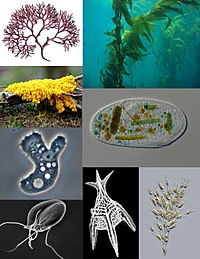
Photo from wikipedia
Abstract Rotaliida is the most diversified order of modern benthic foraminifera, comprising 73 extant families. The current classification of Rotaliida is based exclusively on morphological characters of their calcareous tests.… Click to show full abstract
Abstract Rotaliida is the most diversified order of modern benthic foraminifera, comprising 73 extant families. The current classification of Rotaliida is based exclusively on morphological characters of their calcareous tests. Previous molecular phylogenetic studies partly confirmed morphological classifications but they were based on relatively limited taxon sampling and SSU rRNA gene sequences only. Here, we investigate phylogenetic relationships of rotaliid foraminifera by sequencing complete or partial SSU and LSU rRNA genes for 80 phylotypes representing 70 genera. The analysis of 87 sequences of concatenated genes enabled us to recognize seven rotaliid superfamilies, four of them being established ones (Planorbulinoidea, Discorboidea, Rotalioidea, Nummulitoidea) and three new ones (Glabratelloidea, Calcarinoidea, Serioidea). Although some of these superfamilies were not strongly supported in phylogenetic trees, due to a weak signal of ribosomal genes, they comprise genera and families of distinctive morphological features that have been often united in previous morphology-based classifications. A total of 34 families has been recognized, 10 of them being newly established ones. The placement of three families ( Rubratelliidae , Cymbaloporidae , Murrayinelliidae ), which occupied isolated branches among the seven superfamilies, could not be determined and they are considered here as incertae sedis . An assemblage of 22 genera representing several morphologically different families of small rotaliids (Clade 3) was not raised to superfamily level because of the lack of molecular and/or morphological support. The phylogenetic relations within this assemblage as well as within the superfamily Rotalioidea have been examined in detail by analyzing partial SSU rDNA sequences for large taxon sampling.
Journal Title: Marine Micropaleontology
Year Published: 2017
Link to full text (if available)
Share on Social Media: Sign Up to like & get
recommendations!